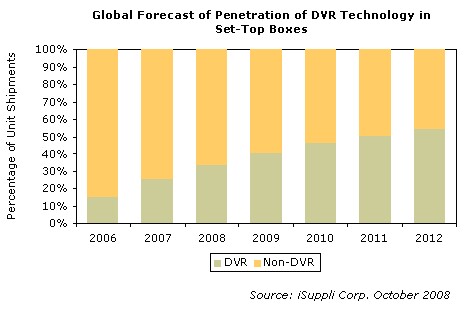Set-Top Box Market to Remain in Flux, iSuppli Predicts
Tuesday, October 14th, 2008
Although Set-Top Boxes (STBs) have been around in one form or another for more than 30 years, the industry is far from settled down. Whether looking at the technology or the business aspects, STBs should remain one of the most dynamic areas of the electronics industry for at least the next decade, and quite possibly beyond, according to iSuppli Corp. The form that the STB may ultimately take is uncertain, but what is certain is that the next decade’s version will look and function quite differently from the box sitting in most people’s living rooms today.
Over the next few years, much of the STB market will be driven by expanding box capabilities. For millions of consumers worldwide, High Definition (HD) and Digital Video Recording (DVR) have become technological necessities of life that they just can’t do without. In fact, HD and DVRs are becoming such a part of consumer lives that by 2012, more than 70 percent of digital Set-Top Boxes (STBs) shipped are expected to integrate support for one or both of these technologies, up from about 35 percent in 2007 according to iSuppli Corp.
“DVRs are cheap to integrate into STBs because Hard Disk Drive (HDD) costs have plummeted so much,” said Jordan Selburn, principal analyst for set-top boxes for iSuppli during a presentation at iSuppli’s North American Briefing here last week. “With the street price of storage just pennies per gigabyte and falling daily, the time is not far off when video storage hardware, whether at home or remote, will be both essentially limitless and virtually free. With cable or satellite companies only charging $5 or so a month for DVR support, who wouldn’t want the ability to record their shows and movies?”
The attached figure shows iSuppli’s forecast of the percentage penetration of DVR technology in digital STBs through the year 2012. The digital STB market consists of satellite, cable, terrestrial and Internet Protocol Television (IPTV) boxes.

“HD falls into a similar category as DVRs,” Selburn said. “HD video processing chips are migrating to 65-nanometer semiconductor manufacturing technologies, causing their incremental costs to drop compared to standard-definition devices. HD display prices are falling rapidly as well. iSuppli forecasts that more than 125 million of these displays will ship in 2008, and customers will demand HD content to watch on their new televisions.”
HD is the new SD
With a perfect storm of lower-cost HD technology, increasing HD content and greater high-speed Internet access, HD will become the mainstream resolution by 2012. This is likely to be a one-time transition, however. While companies are beginning to develop the so-called “Quad Definition” displays with twice the resolution of HD, most consumers will never need to adopt this technology.
“In most cases, today’s HD displays have greater resolution than the human eye can discern,” Selburn said. “Except for those few people buying garage-door-size displays, you will not notice any improvement with Quad Definition–unless, of course, you happen to be an eagle.”
The STB evolution won’t stop when HD and DVRs become the norm, however. In the long term, media hubs and home gateways are destined to supplant today’s one-box-per-set approach. Not only will this lower costs, it will enhance the user experience as well by serving video to all displays in a home from a centralized location.
“We aren’t there yet, but it is possible in the long term,” Selburn said, speaking about the media hub/home gateway approach. “Recording a show in one room and watching it on a device anywhere–that’s the ultimate media-center scenario. And with unlimited storage capacity and wireless connectivity inroads, we’ll get there.”
Latest News
- MagentaTV strengthens addressable TV business with Equativ
- Deutsche Telekom selects Broadpeak Cloud DVR solution for MagentaTV
- Nexxen empowers Australian advertisers using VIDAA ACR data
- TargetVideo integrates AI for video content categorization
- Meta opens Quest OS to third-party hardware makers
- Aferian to implement further cost reductions at Amino